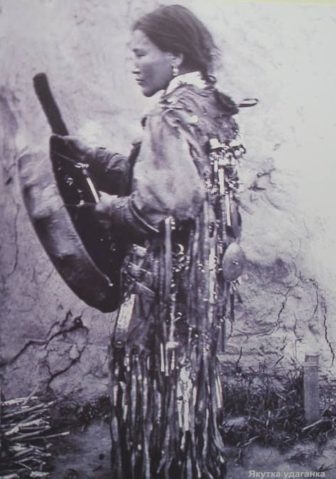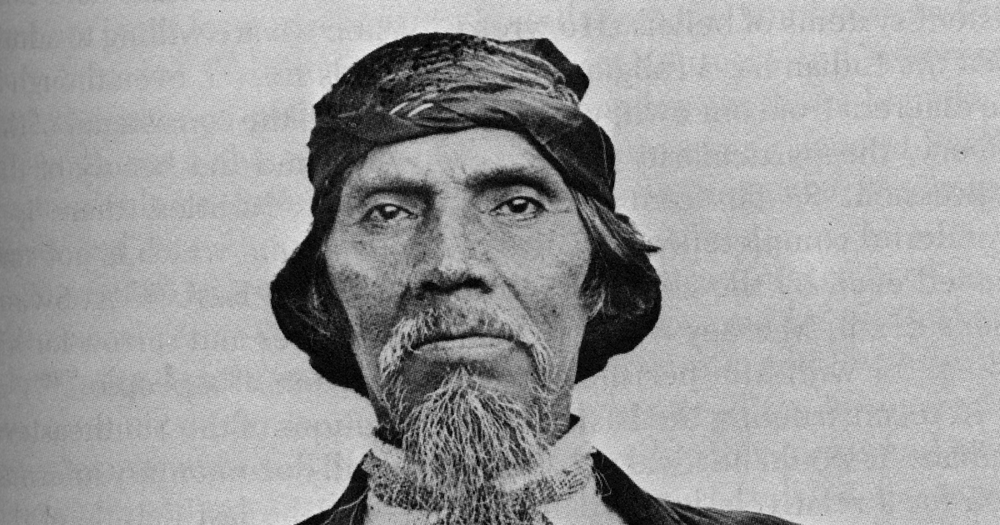Theory of Disease–Animals, Ghosts, Witches
Such is the belief upon which their medical practice is based, and whatever we may think of the theory it must be admitted that the practice is consistent in all its details with the views set forth in the myth. Like most primitive people the Cherokees believe that disease and death are not natural, but are due to the evil influence of animal spirits, ghosts, or witches. Haywood, writing in 1823, states on the authority of two intelligent residents of the Cherokee nation:
 In ancient times the Cherokees had no conception of anyone dying a natural death. They universally ascribed the death of those who perished by disease to the intervention or agency of evil spirits and witches and conjurers who had connection with the Shina (Anisgi’na) or evil spirits. * * * A person dying by disease and charging his death to have been procured by means of witchcraft or spirits, by any other person, consigns that person to inevitable death. They profess to believe that their conjurations have no effect upon white men.[1]
In ancient times the Cherokees had no conception of anyone dying a natural death. They universally ascribed the death of those who perished by disease to the intervention or agency of evil spirits and witches and conjurers who had connection with the Shina (Anisgi’na) or evil spirits. * * * A person dying by disease and charging his death to have been procured by means of witchcraft or spirits, by any other person, consigns that person to inevitable death. They profess to believe that their conjurations have no effect upon white men.[1]
On the authority of one of the same informants, he also mentions the veneration which “their physicians have for the numbers four and seven, who say that after man was placed upon the earth four and seven nights were instituted for the cure of diseases in the human body and the seventh night as the limit for female impurity.”[2]
Viewed from a scientific standpoint, their theory and diagnosis are entirely wrong, and consequently we can hardly expect their therapeutic system to be correct. As the learned Doctor Berendt states, after an exhaustive study of the medical books of the Mayas, the scientific value of their remedies is “next to nothing.” It must be admitted that many of the plants used in their medical practice possess real curative properties, but it is equally true that many others held in as high estimation are inert. It seems probable that in the beginning the various herbs and other plants were regarded as so many fetiches and were selected from some fancied connection with the disease animal, according to the idea known to modern folklorists as the doctrine of signatures. Thus at the present day the doctor puts into the decoction intended as a vermifuge some of the
[1. Haywood, John: Natural and Aboriginal History of East Tennessee, 267-8, Nashville, 1823.
2. Ibid., p. 281.]
red fleshy stalks of the common purslane or chickweed (Portulaca oleracea), because these stalks somewhat resemble worms and consequently must have some occult influence over worms. Here the chickweed is a fetich precisely as is the flint arrow bead which is put into the same decoction, in order that in the same mysterious manner its sharp cutting qualities may be communicated to the liquid and enable it to cut the worms into pieces. In like manner, biliousness is called by the Cherokees dalâ’nï or “yellow,” because the most apparent symptom of the disease is the vomiting by the patient of the yellow bile, and hence the doctor selects for the decoction four different herbs, each of which is also called dalânï, because of the color of the root, stalk, or flower. The same idea is carried out in the tabu which generally accompanies the treatment. Thus a scrofulous patient must abstain from eating the meat of a turkey, because the fleshy dewlap which depends from its throat somewhat resembles an inflamed scrofulous eruption. On killing a deer the hunter always makes an incision in the hind quarter and removes the hamstring, because this tendon, when severed, draws up into the flesh; ergo, any one who should unfortunately partake of the hamstring would find his limbs draw up in the same manner.
There can be no doubt that in course of time a haphazard use of plants would naturally lead to the discovery that certain herbs are efficacious in certain combinations of symptoms. These plants would thus come into more frequent use and finally would obtain general recognition in the Indian materia medica. By such a process of evolution an empiric system of medicine has grown up among the Cherokees, by which they are able to, treat some classes of ailments with some degree of success, although without any intelligent idea of the process involved. It must be remembered that our own medical system has its remote origin in the same mythic conception of disease, and that within two hundred years judicial courts have condemned women to be burned to death for producing sickness by spells and incantations, while even at the present day our faith-cure professors reap their richest harvest among people commonly supposed to belong to the intelligent classes. In the treatment of wounds the Cherokee doctors exhibit a considerable degree of skill, but as far as any internal ailment is concerned the average farmer’s wife is worth all the doctors in the whole tribe.
The faith of the patient has much to do with his recovery, for the Indian has the same implicit confidence in the shaman that a child has in a more intelligent physician. The ceremonies and prayers are well calculated to inspire this feeling, and the effect thus produced upon the mind of the sick man undoubtedly reacts favorably upon his physical organization.
The following list of twenty plants used in Cherokee practice will give a better idea of the extent of their medical knowledge than could be conveyed by a lengthy dissertation. The names are given in the order in which they occur in the botanic notebook filled on the reservation, excluding names of food plants and species not identified, so that no attempt has been made to select in accordance with a preconceived theory. Following the name of each plant are given its uses as described by the Indian doctors, together with its properties as set forth in the United States Dispensatory, one of the leading pharmacopœias in use in this country.[1] For the benefit of those not versed in medical phraseology it may be stated that aperient, cathartic, and deobstruent are terms applied to medicines intended to open or purge the bowels, a diuretic has the property of exciting the flow of urine, a diaphoretic excites perspiration, and a demulcent protects or soothes irritated tissues, while hæmoptysis denotes a peculiar variety of blood-splitting and aphthous is an adjective applied to ulcerations in the mouth.
